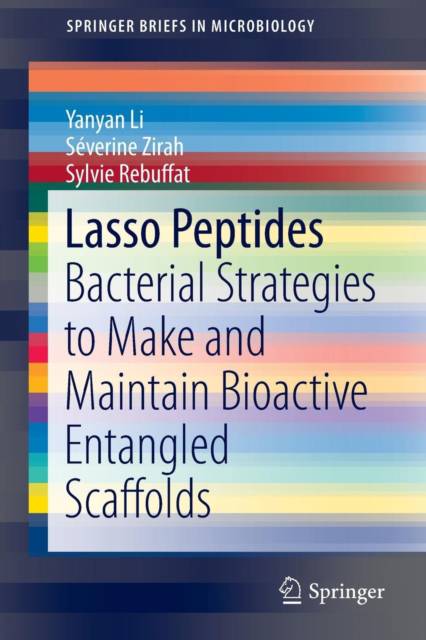
- Afhalen na 1 uur in een winkel met voorraad
- Gratis thuislevering in België vanaf € 30
- Ruim aanbod met 7 miljoen producten
- Afhalen na 1 uur in een winkel met voorraad
- Gratis thuislevering in België vanaf € 30
- Ruim aanbod met 7 miljoen producten
Lasso Peptides
Bacterial Strategies to Make and Maintain Bioactive Entangled Scaffolds
Yanyan Li, Séverine Zirah, Sylvie RebuffatOmschrijving
Lasso peptides form a growing family of fascinating ribosomally-synthesized and post-translationally modified peptides produced by bacteria. They contain 15 to 24 residues and share a unique interlocked topology that involves an N-terminal 7 to 9-residue macrolactam ring where the C-terminal tail is threaded and irreversibly trapped. The ring results from the condensation of the N-terminal amino group with a side-chain carboxylate of a glutamate at position 8 or 9, or an aspartate at position 7, 8 or 9. The trapping of the tail involves bulky amino acids located in the tail below and above the ring and/or disulfide bridges connecting the ring and the tail. Lasso peptides are subdivided into three subtypes depending on the absence (class II) or presence of one (class III) or two (class I) disulfide bridges. The lasso topology results in highly compact structures that give to lasso peptides an extraordinary stability towards both protease degradation and denaturing conditions. Lasso peptides are generally receptor antagonists, enzyme inhibitors and/or antibacterial or antiviral (anti-HIV) agents. The lasso scaffold and the associated biological activities shown by lasso peptides on different key targets make them promising molecules with high therapeutic potential. Their application in drug design has been exemplified by the development of an integrin antagonist based on a lasso peptide scaffold. The biosynthesis machinery of lasso peptides is therefore of high biotechnological interest, especially since such highly compact and stable structures have to date revealed inaccessible by peptide synthesis. Lasso peptides are produced from a linear precursor LasA, which undergoes a maturation process involving several steps, in particular cleavage of the leader peptide and cyclization. The post-translational modifications are ensured by a dedicated enzymatic machinery, which is composed of an ATP-dependent cysteine protease (LasB) and a lactam synthetase (LasC) that form an enzymatic complex called lasso synthetase. Microcin J25, produced by Escherichia coli AY25, is the archetype of lasso peptides and the most extensively studied. To date only around forty lasso peptides have been isolated, but genome mining approaches have revealed that they are widely distributed among Proteobacteria and Actinobacteria, particularly in Streptomyces, making available a rich resource of novel lasso peptides and enzyme machineries towards lasso topologies.
Specificaties
Betrokkenen
- Auteur(s):
- Uitgeverij:
Inhoud
- Aantal bladzijden:
- 103
- Taal:
- Engels
- Reeks:
Eigenschappen
- Productcode (EAN):
- 9781493910090
- Verschijningsdatum:
- 22/10/2014
- Uitvoering:
- Paperback
- Formaat:
- Trade paperback (VS)
- Afmetingen:
- 156 mm x 234 mm
- Gewicht:
- 176 g

Alleen bij Standaard Boekhandel
Beoordelingen
We publiceren alleen reviews die voldoen aan de voorwaarden voor reviews. Bekijk onze voorwaarden voor reviews.











